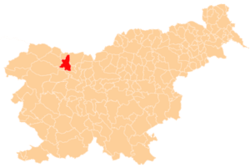Srednja Dobrava
Srednja Dobrava (pronounced [ˈsɾeːdnja dɔˈbɾaːʋa]) is a settlement in the Municipality of Radovljica in the Upper Carniola region of Slovenia.
Srednja Dobrava | |
|---|---|
.jpg) | |
 Srednja Dobrava Location in Slovenia | |
| Coordinates: 46°18′22.75″N 14°13′10.17″E | |
| Country | |
| Region | Upper Carniola |
| Statistical region | Upper Carniola |
| Municipality | Radovljica |
| Elevation | 498.2 m (1,634.5 ft) |
| Population (2002) | |
| • Total | 112 |
| [1] | |
Geography
Srednja Dobrava stands on a plain extending 500 meters (1,600 ft) between the Sava Valley and the Lipnica, which runs parallel to the Sava below the Jelovica Plateau. Woods and fields, interrupted in places by karst sinkholes, gently descend from Kamna Gorica to Podnart. The local community of Srednja Dobrava encompasses the villages of Srednja Dobrava (literally, 'lower Dobrava'), Spodnja Dobrava ('lower Dobrava'), Zgornja Dobrava ('upper Dobrava'), Mišače, and Lipnica. The parish church in the village is dedicated to the Exaltation of the Cross and belongs to the Archdiocese of Ljubljana.[2]
History
The village was attested for the first time in 1368 as Hard (German for 'plain' or 'leafy forest'),[3] and in 1498 as Nadabra.[4] Iron ore was collected and melted by metal workers in Kropa and Kamna Gorica. The only remnant of this period is the entrance into the Štolm Tunnel, dating back to the 18th century, which cuts through the Dobrava Plain from west to east. Farms in Dobrava supplied the metalworkers of Kropa and Kamna Gorica with wheat. On December 5, 1941 German forces arrested 42 families and sent 23 families (81 people of a total population of 352) into forced labor in Germany; December 5 is the local memorial holiday. In the cemetery there is a monument to 18 residents that died as Partisans or were shot in retribution by the Germans during the Second World War. The central figure of the resistance in Dobrava was the teacher Stane Žagar.[5]
Culture and tourism
Dobrava is accessible by road from four directions: 1) from the south from the road from Kranj to Kropa, 2) from the north from the highway or the old route from Kranj to Radovljica via the Brezje (Dobro Polje) exit, 3) from the north from the road from Radovljica to Kropa at the Lipnica exit, and 4) from the south from the road from Kranj to Kropa at Podnart exit. By train, hikers can use three railway stations: Podnart, Otoče, or Globoko. It takes 30 minutes to reach Dobrava through the steep woods from Otoče and somewhat longer to get there from the other two stations. There are nice views of the Sava River and the Karawanks from the viewing points at Ojstra Peč and Stovc on the northern edge of the Dobrava Plain, and a picturesque church at Jamnik can be seen from the middle of the plain. The Jakob Aljaž memorial trail crosses Dobrava; Aljaž was a priest at Dobrava at the end of the 19th century. Other notable residents or visitors to the area were the priest Janez Jalen, writer Joža Lovrenčič, painter Božidar Jakac, photographer Janko Balantič, and rowing champion Luka Špik. A restaurant with a garden is located in the middle of the village, and is a stopping point for bikers, strollers, and pilgrims to the church in Brezje and horse riders. In the winter, the Dobrava Plain is used for cross-country skiing and skating. It is a 30-minute walk to Kropa, where the forging museum is located. It takes one or two hours on foot to reach the Jamnik church on the slopes of Jelovica, the Partisan Lodge at Vodice Pasture on the Jelovica Plateau above Kropa, Radovljica (crossing the Sava River on the Fuks Footbridge), and the ruins of Lipnica Castle.
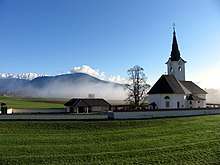 Local church |
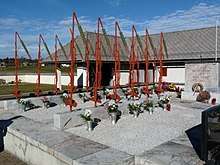 Monument to victims of Nazism |
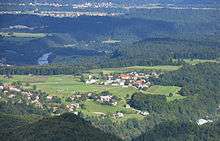 View of Zgornja Dobrava and Srednja Dobrava from the Jelovica Plateau |
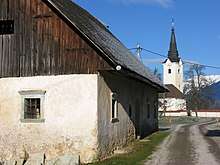 Sexton's house, no longer inhabited |
References
- Statistical Office of the Republic of Slovenia
- Družina RC Church in Slovenia journal web site
- Hard. Gerhard Köbler: Althochdeutsches Wörterbuch.
- Milko Kos: Gradivo za historično topografijo Slovenije (za Kranjsko do leta 1500). Ljubljana: Inštitut za občo in narodno zgodovino Slovenske akademije znanosti in umetnosti, 1975.
- Ivan Križnar: Dobravci doma in v izgnanstvu: Utrinki iz Dobravske kronike. Srednja Dobrava: Krajevni odbor društva izgnancev, 1997.
External links
| Wikivoyage has a travel guide for Srednja Dobrava. |

- Srednja Dobrava at Geopedia
- The Dobrava villages: The sources for the history of Dobrava till 1945, The cronicle of Dobrava since 1945, Dobrava Who is who, Dobrava houses. Wikibook (in Slovene).
- Tourist leaflet.
